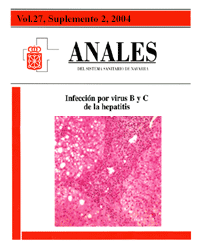Virology, diagnostic tests, epidemiology and transmission
Keywords:
Virus hepatitis C. Estructura. Genotipos. Quasiespecies. Epidemiología. Transmisión.Abstract
The hepatitis C virus is a human virus, classified within a third type (Hepacivirus) of the Flaviviridae family. It is a spherical virus, of approximately 50 nm in diameter, with a glycoprotein covering that contains lipids, and its genome is a simple chain RNA molecule. It is characterised by a high degree of genomic heterogeneity, whose evolutionary consequence in the long term is the appearance of genetically different viral groups, genotypes and quasispecies. There are different diagnostic techniques for detecting hepatitis C virus infection. Serological assays: the detection of specific IgG against HCV by means of enzyme immunoassays is the most practical method for diagnosing infection by this virus. Supplementary immunblot tests are employed to confirm the specificity of the results of the EIA test. Molecular assays: qualitative and quantitative techniques have been developed for detecting RNA-HCV, based on the direct detection of the virions. The pathogeny of hepatitis C is not well understood. Its world prevalence is estimated at some 3%, which is why routine screening for its detection is not recommended. HCV transmission basically occurs through percutaneous exposure to infected blood, with higher rates observed in imprisoned persons, vagabonds, intravenous drug addicts, haemophiliacs and patients on haemodialysis. Although it can be transmitted sexually, it seems that this path is not very efficient, with a greater prevalence observed in persons with multiple sexual partners. Vertical transmission is estimated at some 2%, reaching 20% in cases of maternal coinfection with HIV.Downloads
Downloads
Published
How to Cite
Issue
Section
License
La revista Anales del Sistema Sanitario de Navarra es publicada por el Departamento de Salud del Gobierno de Navarra (España), quien conserva los derechos patrimoniales (copyright ) sobre el artículo publicado y favorece y permite la difusión del mismo bajo licencia Creative Commons Reconocimiento-CompartirIgual 4.0 Internacional (CC BY-SA 4.0). Esta licencia permite copiar, usar, difundir, transmitir y exponer públicamente el artículo, siempre que siempre que se cite la autoría y la publicación inicial en Anales del Sistema Sanitario de Navarra, y se distinga la existencia de esta licencia de uso.








